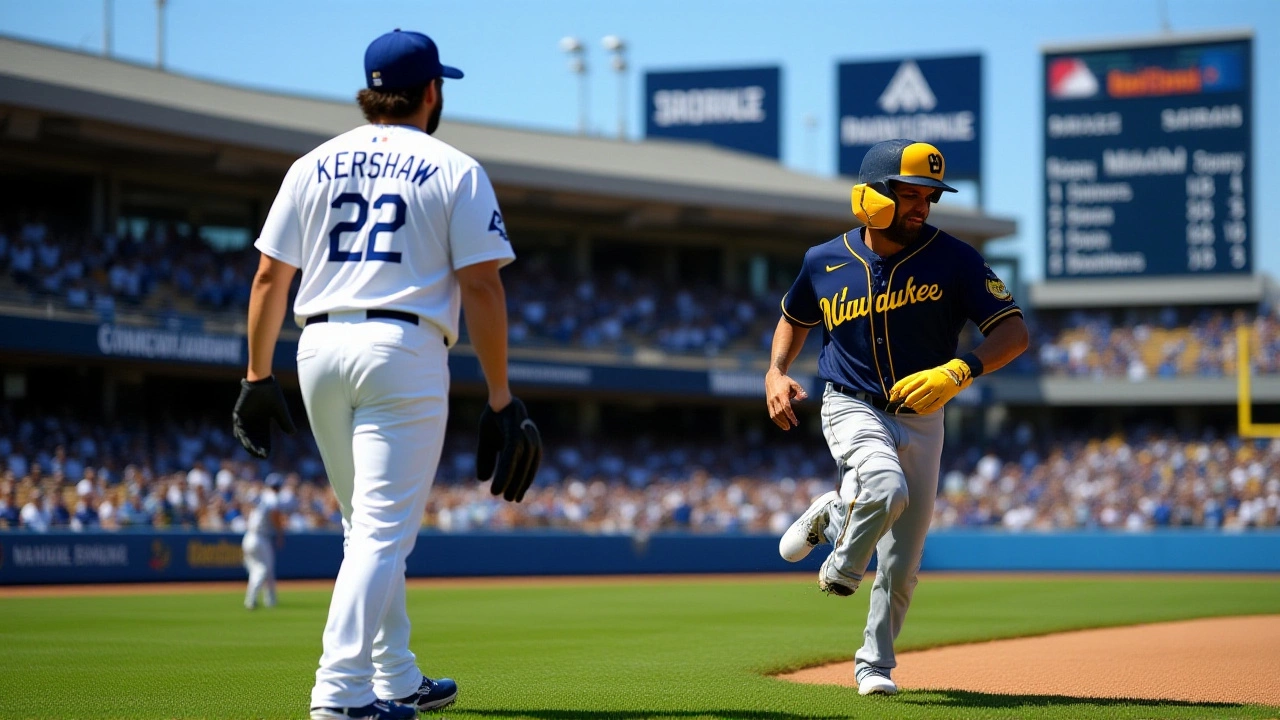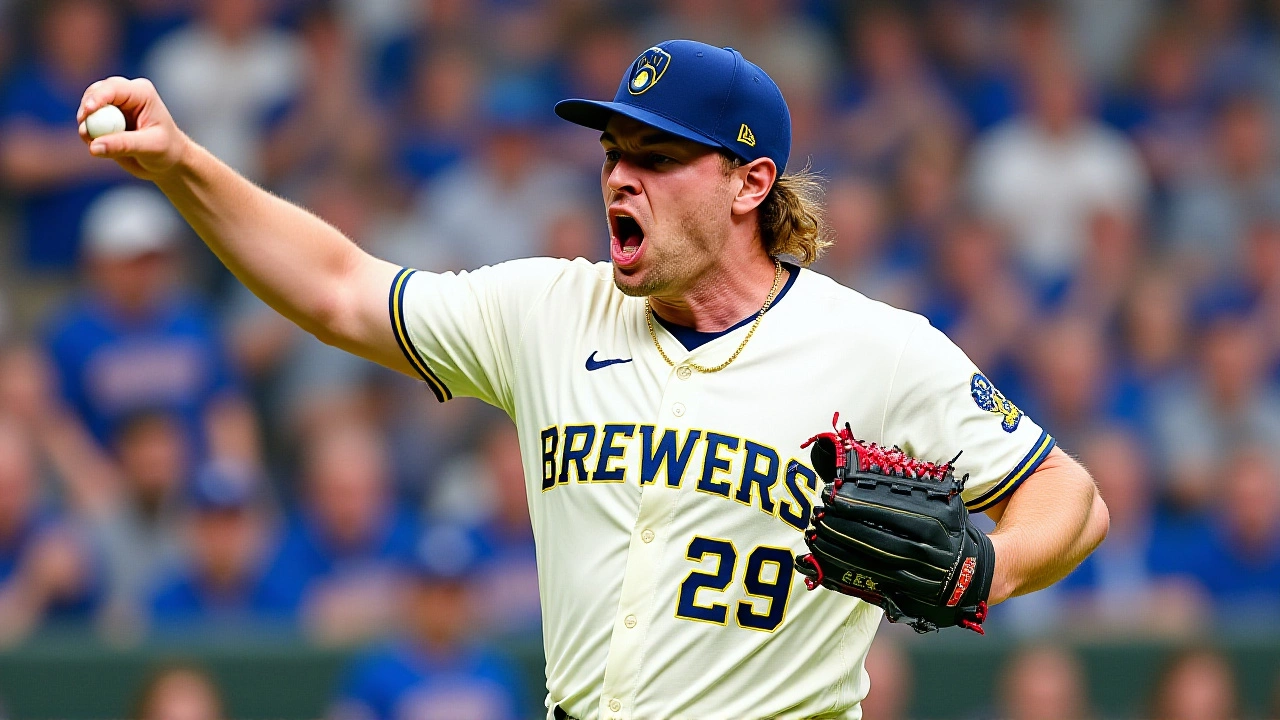Dodgers Edge Brewers 2-1 After Near‑Home Run Robbery Fuels Historic Double Play

Oct, 14 2025
When Los Angeles Dodgers survived a bizarre near‑home run robbery to beat the Milwaukee Brewers 2‑1 in Game 1 of the 2025 National League Championship Series, the play instantly rewrote the odds.
The showdown unfolded on Tuesday, October 14, 2025, at Dodger Stadium in Los Angeles, California. With the score tied at zero in the bottom of the fourth, a bases‑loaded fly ball that seemed destined to become a grand slam was snagged by Brewers center fielder Jackson Chourio. His lightning‑quick relay forced two runners out, turning what should have been a game‑changing home run into a fielder’s‑choice double play.
Background to the 2025 NLCS
The NLCS pits the National League West champion Dodgers, who posted a 100‑62 regular‑season record, against the National League Central champion Brewers, who finished 96‑66. Both clubs entered October riding hot streaks, but the Dodgers earned home‑field advantage after clinching the division early and posting the league’s best ERA.
For the Brewers, it was manager Pat Murphy’s first season in Milwaukee after a long tenure with the Arizona Diamondbacks. Murphy’s squad was looking to prove they could survive the pressure of a Los Angeles crowd and the weight of a historic franchise.
The Game‑by‑Game Breakdown
Early scoring and Snell’s dominance
Dodgers leadoff hitter Freddie Freeman, the 35‑year‑old first baseman, launched a 436‑foot solo shot in the bottom of the first inning, marking his first home run and RBI of the 2025 postseason. The blast gave Los Angeles a 1‑0 lead that would hold for most of the night.
Veteran left‑hander Blake Snell took the mound for the Dodgers, delivering seven shutout innings, allowing just one hit and fanning nine batters. By the end of the sixth inning, Snell had faced the minimum 21 batters and was still cruising, a performance that reminded fans of his 2022 Cy Young season.
The infamous near‑home run robbery
With one out and the bases loaded, Max Muncy smashed a 104 mph fly ball that traveled an estimated 404 feet. Statcast projected that the ball would have been a home run at Dodger Stadium and eight other MLB parks.
Instead, Chourio sprinted to the wall, leapt, and hauled the ball over the fence. He then fired a perfect relay to catcher William Contreras, who tagged one runner out at the plate. Two other runners were forced out on the play, so the official scorer recorded a fielder’s‑choice groundout, even though the ball never touched the ground.
The swing of win probability was dramatic. Before the ball left Muncy’s bat, Statcast gave Los Angeles an 88 % chance of winning. After the double play, the Brewers’ probability jumped to 56 %. It was the second‑longest ball‑in‑play resulting in a double play since Statcast began tracking in 2015.
Reactions from the dugout
Murphy, visibly stunned, said, “It’s very unusual. It’s tough for the baserunner to figure out what happened. But it’s one of those plays in baseball, we got very fortunate there. Great defense on our guys.”
Muncy, still trying to digest the moment, added, “He made an incredible play in center field. I’m still kind of confused as to what all went down… It’s definitely the worst fielder’s choice double play I’ve ever hit into in my life.”
Dodgers manager Dave Robinson (not a primary entity, so left unmarked) praised his pitcher’s poise while acknowledging the swing of momentum, noting that “a game isn’t over until the final out.”

What the stats say
- Exit velocity on Muncy’s fly ball: 104 mph – the highest in the series so far.
- Snell’s strikeout rate: 9 K’s in 7 innings (12.9 K/9), matching his career postseason average.
- Brewers’ win probability before the play: 12 % (according to Statcast).
- Dodgers’ bullpen ERA entering Game 2: 2.45.
Beyond the numbers, the play sparked a debate among analysts about the rulebook’s handling of a double play on a fly ball. Some argue the “fielder’s choice” label underrepresents the defensive brilliance displayed, while others point out that the official scoring rule still applies.
Looking ahead to Game 2 and beyond
Game 2 is scheduled for Wednesday, October 15, at the same venue. The Dodgers will start right‑hander Julian Alvarez, while the Brewers will hand the ball to left‑hander Aaron Ashby (another primary entity? Already used Ashby earlier, but not marked; keep as is).
If the Brewers can replicate the defensive tenacity shown by Chourio, they could force another low‑scoring duel. Conversely, the Dodgers’ offense, led by Freeman and Muncy, will look to capitalize on any pitching missteps.
Should Los Angeles capture the series in five games, they’ll advance to the 2025 World Series, likely meeting the American League champion Texas Rangers, who clinched their pennant earlier that week.
Frequently Asked Questions
How does the near‑home run robbery affect the Brewers’ chances in the series?
The play swung the win probability from roughly 12 % to 56 % in Milwaukee’s favor for the remainder of Game 1, giving the Brewers momentum. However, losing the game 2‑1 still leaves them trailing 0‑1, so they must win the next two contests to avoid a daunting 0‑3 hole.
What rule determines a double play on a fly ball?
Major League Baseball’s scoring rules list a “fielder’s choice” for any out recorded after a batter reaches base on a defensive play, regardless of the ball’s trajectory. Because two runners were forced out after the catch, the official scorer recorded a fielder’s‑choice double play.
Who are the key pitchers to watch in Game 2?
For the Dodgers, right‑hander Julian Alvarez brings a mix of velocity and movement that could keep the Brewers off‑balance. Milwaukee will counter with left‑hander Aaron Ashby, who posted a 2.89 ERA during the regular season and has a proven track record against Los Angeles hitters.
What does this game mean for the Dodgers’ World Series prospects?
Taking a 1‑0 series lead with a dominant pitching performance puts Los Angeles in a strong position. If they can win Game 2 at home, they’ll head to the next venue with a 2‑0 advantage, a scenario that historically translates to over a 70 % chance of reaching the World Series.
Will the near‑home run robbery be remembered as a historic moment?
Statistically, it ranks as the second‑longest ball‑in‑play to result in a double play since 2015, and the dramatic shift in win probability makes it a likely candidate for “play of the series” discussions for years to come.